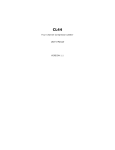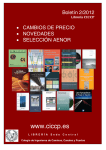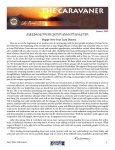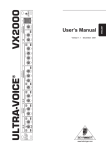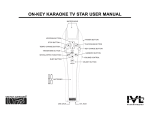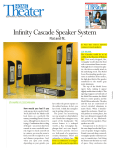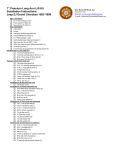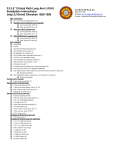Download ACP22 Owner`s Manual
Transcript
ACP-22 Two Channel Stereo Compressor/Limiter/Gate User's Manual VERSION 1.1 PreSonus Limited Warranty PreSonus Audio Electronics Inc. warrants this product to be free of defects in material and workmanship for a period of one year from the date of original retail purchase. This warranty is enforceable only by the original retail purchaser. To be protected by this warranty, the purchaser must complete and return the enclosed warranty card within 14 days of purchase. During the warranty period PreSonus shall, at its sole and absolute option, either repair or replace, free of charge, any product that proves to be defective on inspection by PreSonus or its authorized service representative. To obtain warranty service, the purchaser must first call or write PreSonus at the address and telephone number printed below to obtain a Return Authorization Number and instructions of where to return the unit for service. All inquiries must be accompanied by a description of the problem. All authorized returns must be sent to the PreSonus repair facility postage prepaid, insured and properly package. Proof of purchase must be presented in the form of a bill of sale, canceled check or some other positive proof that the product is in within the warranty period. PreSonus reserves the right to update any unit returned for repair. PreSonus reserves the right to change or improve design of the product at any time without prior notice. This warranty does not cover claims for damage due to abuse, neglect, alteration or attempted repair by unauthorized personnel, and is limited to failures arising during normal use that are due to defects in material or workmanship in the product. Any implied warranties, including implied warranties of merchantability and fitness for a particular purpose, are limited in duration to the length of this limited warranty. Some states do not allow limitations on how long an implied warranty lasts, so the above limitation may not apply to you. In no event will PreSonus be liable for incidental, consequential or other damages resulting from the broach of any express or implied warranty, including , among other things, damage to property, damage based on inconvenience or on loss of use of the product, and, to the extent permitted by law, damages for personal injury. Some states do not allow the exclusion of limitation of incidental or consequential damages, so the above limitation or exclusion may not apply to you. This warranty gives you specific legal rights, and you may also have other rights which vary form state to state. This warranty only applies to products sold and used in the United States of America. For warranty information in all other countries please refer to your local distributor. Limited Warranty Outside of the U.S. PreSonus Audio Electronics products are warranted only in the country where purchased, through the authorized PreSonus distributor in that country, against defects in material and workmanship. The specific period of this limited warranty shall be that which is described to the original retail purchaser by the authorized PreSonus dealer or distributor at the time of purchase. PreSonus does not, however, warrant its products against any and all defects: 1) arising Out of materials or workmanship not provided or furnished by PreSonus, or 2) resulting from abnormal use of the product or use in violation of instructions, or 3) in products repaired or serviced by other than authorized PreSonus repair facilities, or 4) in products with removed or defaced serial numbers, or 5) in components or parts or products expressly warranted by another manufacturer. PreSonus agrees, through the applicable authorized distributor, to repair or replace defects covered by this limited warranty with parts or products of original or improved design, at its option in each respect, if the defective product is shipped prior to the end of the warranty period to the designated authorized PreSonus warranty repair facility in the country where purchased, or to the PreSonus factory in the U.S., in the original packaging or a replacement supplied by PreSonus, with all transportation cost and full insurance paid each way by the purchaser or owner. All remedies and the measure of damages are limited to the above services. It is possible that economic loss or injury to person or property may result from the failure of the product; However, even if PreSonus has been advised of this possibility, this limited warranty does not cover any such consequential or incidental damages. Some states or countries do not allow the limitations or exclusion of incidental or consequential damages, so the above limitation may not apply to you. Any and all warranties, express or implied, arising by law, course of dealing, course of performance, usage of trade, or otherwise, including but not limited to implied warranties of merchantability and fitness for a particular purpose, are limited to a period of two years from either the date of original retail purchase or, in the event no proof of purchase date is available, the date of manufacture. Some states or countries do not allow limitations on how long an implied warranty last, so the above limitations may not apply to you. This limited warranty gives you specific legal rights, and you may also have other rights which vary from state to state, country to country. PreSonus Audio Electronics, Inc. 7257 Florida Blvd. Baton Rouge, LA 70806 225-216-7887 www.presonus.com ©1997, PreSonus Audio Electronics, Incorporated. All rights reserved. TOC Table of Contents 1 Overview 1.1 Introduction 1.2 Features 2 Controls & Connections 2.1 Front Panel Basic Layout 2.2 Compressor Controls 2.3 Gate Controls 2.4 Gain 2.5 Bypass & Link 2.6 Patch Panel 2.7 Power 3 Basic Setup & Applications 3.1 Some Basic Patching 3.2 Basic Applications 4 Technical 4.1 Specifications A Appendix A word about compression... TOC (Intentionally Blank) Overview 1.1 Introduction Thank you for purchasing the PreSonus ACP-22 dual channel/stereo dynamics processor with full featured gates. This processor was designed using state of the art components to deliver crystal clear compression and noise gating for an infinite period of time. We believe that it is an exceptional sounding unit as well as an exceptional value. Feel free to contact us at 1-800-750-0323 anytime for any reason whatsoever. We value your suggestions and your comments! Please pay close attention to how you connect your ACP-22 to your system. Improper grounding is the most common cause of noise problems found in studio or live sound systems. We urge you to at least scan this manual before hooking up your ACP-22 to become familiar with its features and various applications. Good luck and enjoy your ACP-22! 1.2 Features The following is a summary of your ACP-22's features: · Full Featured Compressors/Limiters. Both channels of your ACP-22 contains an audio compressor that can also be setup as a limiter by varying the ratio of compression. You have broad control over threshold, ratio, attack and release for each processor. You can select between auto or manual attack and release curves and hard or soft knee compression types (refer to the application section of this manual for a quick tutorial on compression and limiting). The compressor will prove to be very useful in many situations such as recording instruments or vocals that vary in loudness, or setting it up as a soft limiting device before your digital recorder to prevent distorting your digital recorder's inputs. The stereo mode of operation is ideal for use on the master output of your console whether you are mixing down or for live sound reinforcement. Two Dynamic Noise Gates. Both channels of your ACP-22 have a separate dynamic noise gate that can be used to gate a drum, clean up a noisy tape machine, isolate an instrument or separate a vocal from background noises. Each noise gate provides control over attack, threshold, release and gate Overview close range. The gate close range is useful for creating a more natural, acoustic sounding blend or mix. · Stereo Channel Linking. Using the Link function, you can link together both channels of the ACP-22 for stereo operation. When linked, both processors follow the setting of channel one which becomes the master. · Separate Bypass and Gain for Both Channels. Both channels have a separate bypass for listening to 'before and after' performance tests and a gain control to make up for any level lost from compression. · Compressor Sidechain Jack on Each Channel. Both channels of your ACP-22 were designed with a special jack for spectral processing, compression keying and ducking applications. Sidechaining is useful for removing annoying sibilance from vocal tacks (de-essing) or automatically ducking tracks behind a narrator for 'auto mixing' a service, broadcast or performance. When both channels are linked together, the send of the sidechain jack of the master channel contains a mix of both the channels in the link; a cool feature that allows for control over both channels of processing with one sidechain send/return. (See the section on sidechaining for application notes.) · Separate Gate Keying Jacks for Each Channel. Your ACP22 also includes a separate jack on each channel for gate keying. This is useful for synching an external sound to a snare track for example or putting equalizers or filters before the gate key to enable gating only the lower frequency of a kick drum, etc. · Balanced XLR and Unbalanced 1/4" Tip/Sleeve Inputs and Outputs. Your ACP-22 accepts XLR connectors for balanced or 1/4" TS for unbalanced inputs and outputs. · +4dBu or -10dBV. The internal operating level of your ACP-22 can be switched between +4dBu (pro levels) to -10dBV (line levels) for ease of use in any situation. Overview To Get Help... Call Us: 1-800-750-0323, 9AM to 5PM, CST Visit our World Wide Web site: http://www.presonus.com Email Us: [email protected] Controls & Connections 2.1 Front Panel Basic Layout Notice that the front panel is divided into two identical sections. These are the two signal processing channels of the ACP-22. Each channel contains: · Compressor/Limiter; · Noise Gate; · Gain (output control); · Link & Bypass Control. 2.2 Compressor Controls Threshold The Compressor threshold sets the level at which the onset of compression begins. When the signal is above the threshold setting, it becomes 'eligible' for compression. Turning the threshold knob counterclockwise causes more of the input signal to become compressed if you have a ratio setting of greater than 1:1. Controls & Connections Ratio Ratio sets the compression slope. This can be defined as the output level versus the input level. For example, if you have the ratio set to 2:1, any signal levels above the threshold setting will be compressed at a compression ratio of 2:1. This means that for every ldB of level increase into the compressor, the output will only increase 1/2dB, thus producing a compression gain reduction of 0.5dB. As you increase the ratio, the compressor gradually becomes a limiter. A limiter is defined as a processor that limits the level of a signal to the setting of the threshold. For example, if you have the threshold knob set at 0dB, and the ratio turned fully clockwise, the compressor becomes a limiter at 0dB. This means that the signal will be limited to an output of 0dB regardless of the level of the input signal. Attack Attack sets the speed at which the compressor 'acts' on the input signal. A slow attack time (fully clockwise) allows the beginning envelope of a signal (commonly referred to as the initial transient) to pass through the compressor uncompressed, whereas a fast attack time (fully counterclockwise) subjects .the signal to the ratio and threshold settings of the compressor instantaneously. The Attack control is only active when the Auto button is not pushed in. When the auto button is pushed in, the compressor automatically determines the appropriate attack time for compression. Release Release sets the length of time the compressor takes to return the gain reduction back to zero (no gain reduction). Very short release times can produce a very choppy or 'jittery' sound, especially in low frequency instruments such as a bass guitar. Very long release times can result in an over compressed sound, sometimes referred to as 'squashing' the sound. All ranges of release can be useful at different times. You should experiment to become familiar with the different sound possibilities. (Refer to the applications section of this manual for some ideas.) Controls & Connections The Release control is only active when the Auto button is not pushed in. When the auto button is pushed in, the compressor automatically determines the appropriate release time for compression. Soft The Soft button selects from soft knee and hard knee compression curves. When this button is pushed in, soft knee compression curves are used, otherwise hard knee compression curves are used. With hard knee compression, the gain reduction applied to the signal occurs as soon as the signal exceeds the level set by the threshold. With soft knee compression, the onset of gain reduction occurs gradually after the signal has exceeded the threshold, producing a more musical response (to some folks). Auto When pushed in, the auto button places the compressor in automatic attack and release mode. The attack and release knobs become inoperative and a pre-programmed attack and release curve is used. 2.3 Gate Controls Threshold The gate threshold sets the level at which the gate opens as indicated by the 'OPEN' LED above the threshold knob. All signals above the threshold setting are passed through unaffected, whereas signals below the threshold setting are reduced in level by the amount set by the range control. The Controls & Connections 'CLOSE' LED above the threshold knob indicates when the gate is closed (the signal level is below the threshold). If the threshold is set fully counter-clockwise, the gate is turned off (always open), allowing all signals to pass through unaffected. Attack The gate attack time setting determines the rate at which the gate opens. Faster attack times are normally useful for gating percussive instruments such as drums, etc. Slowing the attack time will eliminate any 'pops' are 'clicks' in the gate when gating vocals, instruments, etc. Release The gate release time determines the rate (speed) at which the gate closes. This is indicated by observing the OPEN and CLOSE LED's. As the release time is lengthened (clockwise), you will notice that the CLOSE LED reflects the close time. Release times should typically be set so that the natural decay of the instrument or vocal being gated is not affected. Shorter release times help to clean up the noise in a signal but care must be taken, especially with regards to percussive instruments, to avoid gate 'chatter'. Longer release times usually eliminate 'chattering' and should be set by listening carefully for the most natural release of the signal to which the gate is being applied. Range The gate range button sets the amount of gain reduction occurring when the gate closes. Therefore, if the range button is pushed in (led on), the signal will be gated (reduced) by 60dB as it crosses below the threshold. If the gate range button is out (led off), the signal will be gated (reduced) by 6dB as it crosses below the threshold. The CLOSE LED above the threshold knob indicates this by changing brightness relative to the range amount. When the range is set to 60dB, the CLOSE LED will illuminate to its brightest level at the end of the release time which has been set by way of the release control. Filter The filter feature of your ACP-22 modifies the audio signal such that the gate is less sensitive to high frequency instruments. This means that when the filter is active, the gate will only open for those instruments with lower frequencies. The filter is set for -6dB at 2.5kHz. The filter rolls off the high Controls & Connections frequencies at -12dB per octave. This feature is extremely useful when gating drums where it would be great to stop the cymbals from opening up the tom-tom gates, etc. 2.4 Gain Gain When compressing a signal, gain reduction usually results in an overall reduction of level. The gain control allows you to restore the loss in level due to compression. (Like readjusting the volume.) 2.5 Bypass & Link Bypass Activating the bypass effectively removes all processing being performed by your ACP-22 and returns the signal to unity gain. You should use bypass often when setting up your ACP-22 to compare the 'before and after' results of the signal processing effecting your audio signal. Bypass affects both the gate and the compressor. When in Bypass the Link function is interrupted and defeats the stereo link. Link When the Link button is pushed in, channel One becomes the master controller of both channels. Channel Two's controls become disabled and metering becomes summed left and right, i.e. stereo mode. IMPORTANT: When the two channels are linked (link button pushed in), all of channel Two's controls are inactive. Controls & Connections 2.6 Patch Panel (Back) Input The input jacks are unbalanced tip/sleeve connectors or balanced XLR connectors. The input can handle up to +24dBu unbalanced or up to +18dBu balanced signal levels. Output The output jacks accept balanced XLR or unbalanced tip/sleeve connectors. The output will deliver up to +24dBu in signal level, balanced or unbalanced. Cable Connection Diagrams Controls & Connections +4/-10 Switch This switch adjusts the internal operating level of your ACP-22 when it is connected to line level (0dB = -10dBV) gear. With the switch in the '-10' position, the signal is raised internally so that it is processed at the lower noise floor of your ACP-22's internal circuitry. The signal level is lowered on the way out to match up with your line level gear's input. When the switch is in the '+4' position, the signal is not changed since this matches the internal operating level of your ACP-22. This function may also be useful in creating special effects with the compressor and gate of the channel by 'overcompressing' or 'gating'. Compression and Gating Sidechain The sidechain jack on each channel interrupts the signal that the compressor and/or gate is using to detect the audio signal for processing. When no connector is inserted into this jack, the input signal goes directly to the compressors control circuitry (normaled). When a connector is inserted into this jack, the signal path is broken. If you have inserted a tip-ring-sleeve connector, the input signal is sent back out of the ACP-22 via the ring of the connector. This signal can then be processed by an equalizer for example to reduce sibilance (de-essing) in a vocal track. The signal is then returned to the unit via the tip of the connector. The signal sent to the tip could also be that of a narrator or vocalist. In this application, the audio that you are passing through the compressor will automatically 'duck' when the narrator speaks or vocalist sings. Controls & Connections 2.7Power Power Connection The power jack on your ACP-22 accepts a standard IEC cord like those found on most computers and professional recording equipment. Your ACP22 contains a custom built in power supply, no wall wart. (We can't stand them either.) This way you can be assured of clean power combined with rugged construction that has been designed to last! Power Selection Before powering on your ACP-22 for the first time, be sure to check the position of the power selector. Make certain that the power voltage level selected matches that of your country's outlet. Power Switch I = ON, 0 = OFF. (hmmm...) Controls & Connections Notes... Basic Setup & Applications 3.1 Some Basic Patching Inserting into your mixers insert points, unbalanced. After your mixers main outputs, balanced. Basic Setup & Applications Between multi-track recorder inputs/outputs to mixer outputs/inputs, unbalanced. Sidechain insertion of an equalizer, for de-essinq specific frequency gating applications. Basic Setup & Applications 3.2 Basic Applications Example setup compressing a voice or vocal track. Probably the most common use of a compressor is to limit the dynamic range of a vocalist during a live performance or a recording. It is almost always necessary to compress a vocal take during a recording session. Most vocalists have a very wide dynamic range, and if the vocalist does not have 'studio' experience, the dynamic range of the vocal performance can be enhanced by the microphone techniques demonstrated during a session. This wide variation in level makes it difficult to properly record a vocal take, especially in digital multi-track recorders which have definite limitations in headroom. Compressing a vocal also makes it easier to place the vocal track in a mix so that it remains 'in your face' throughout the track. To set up for a vocal take, insert a channel of your ACP-22 into the same channel as the microphone on your mixer. If your mixer has an insert point, insert the compressor there. If you don't have an insert point you will have to place the compressor after your mixer's bus-output or whichever output you're using by coming out of your mixer to the input of the ACP-22; then out of the ACP-22 to the input of your recorder. If you're using a stand alone mic preamp; patch the ACP-22 after the preamp and then to the recorder. Turn the threshold of the channel's compressor you're using completely counter-clockwise. If you've gotten the cables right, you should see the LED's above the threshold knob of the channel you're using flashing when you talk into the microphone. Make sure that the channel on the ACP22 has the following setup: Link button is out, Bypass is out, Auto is in, Soft is out, Gate Threshold knob is fully counter-clock wise, Compressor Ratio knob is set to 1:1 (fully counter clockwise). To set the compressor: turn the ratio to the 2:1 mark on the legend. With the vocalist yodeling into the mic, turn the compressor's threshold until the gain reduction meters read about -7dB. Now you will probably need to boost the compressors' output by turning the Gain knob clockwise so that Basic Setup & Applications your mixer or multi-tracks meters read 0dB (in the case of some digital recorders this is -14dB). This would be a basic, very simple but useable setting for recording a vocal. Things to vary to suit your taste might be: adjusting the ratio and threshold for more/less dynamic range. Push the Soft button in and check out the Soft Knee compression curve. Take the compressor out of Auto mode and adjust the Attack and Release times to taste. Get a new vocalist (just kidding). Patching Using a Patch Bay When using a patch bay to extend the ACP-22's patch panel for easier access, the following should be considered: 1. Lowest noise is achieved when using balanced patch bays. 2. The input and output jacks should not be normalled (the send routed back to the return). 3. The sidechain jacks must be normalled. Compressing and gating drums or percussion instruments. Limiting the dynamic range of a drum kit may or may not be something you want to do to your drum tracks, but there are some other cool things the ACP-22 can do to make your drums really happening. · If you think about how a snare drum sounds, it has a beginning loud sound followed by a usually short decay. Patch a channel of your ACP-22 for compressing the snare drum as described above and we can explore some dramatic changes that good compression has on the snare. For a simple setup, make sure that the: Soft button is out, Auto button is out, Ratio is set to 4:1 on the legend, Attack is fully counterclockwise, Release is straight up at 12:00 o'clock, Gate threshold is fully counter-clockwise, Link button is out and Bypass button is out. Adjust the threshold until you see about -1 dB on the gain reduction meters. At this point, the snare's volume is simply lowered by 1 dB. Now slowly raise the Attack time by turning the attack knob clockwise. You should notice that the beginning 'transient' of you snare sound is starting to jump out Basic Setup & Applications of the speakers and slap you in the face. This is more accentuated when using digital reverberation on the snare. Now you can adjust the Gate on the snare to stop those other drums from 'bleeding' through the snare mic: Turn the gate release knob to about the middle position, turn the gate attack knob to fully counter-clockwise, set the gate range to -60dB, adjust the gate threshold slowly clockwise until you begin to hear those other drums disappearing. Too high of a threshold setting might disrupt the snares natural sound, too low will let those other drums open the gate. You need to adjust the gate's threshold and release to suit your drumming taste. This simple application applies to any percussive instrument of course. Experiment... Limiting. Limiting is defined as compressing with a ratio of infinity to one. Sort of like an imaginary ceiling for the level of a signal. On your ACP-22, limiting occurs when the ratio knob is fully clockwise. At this point, the threshold knob essentially becomes the 'ceiling' knob for the channel. You will most likely want an instantaneous attack time while limiting. To achieve this: Make sure the auto button is out, Turn the attack time knob fully counter-clockwise and set the compressor's release time for the most naturally acoustic sound. (Warning: Improper settings of the release time have been known to cause pumping, breathing and coughing in limiters. Consult your ears when fine tuning.) Compressing bass guitar. Very similar to compressing vocals, the bass guitar is almost always compressed or limited during recording. Start with the setting described above for vocals. Vary the compression ratio, attack and release to suite your taste. Compressing acoustic guitar. It is sometimes easy to over compress an acoustic guitar because your first impression is that compression sounds awesome on acoustic instruments. If you're adding the acoustic instrument to a mix that includes Basic Setup & Applications lots of other instruments such as distorted guitar, compressing the life out of your guitar will help you later in the mix. If the guitar is recorded as a solo instrument or part of an acoustic ensemble, you should experiment with less compression because you don't want to severely limit the natural acoustic dynamic range of a good sounding guitar. Start by using the setup described in the vocal section... De-essing using an inserted equalizer into the sidechain. A common annoyance when placing a vocal track in a mix is that as you boost the higher frequencies of the track to 'breath life' into the vocal, all of the 'SSS's of the dialogue or lyrics tend to become louder than the rest of the track. A proven method of redusssing thissss problem is to de-ess the track with 'spectral' compression. Patching a de-esser together is illustrated in the patching diagrams above. If you don't have an external equalizer, you can use a spare channel of your mixer by sending the track to both the spare channel and the original channel. Take the direct out of the spare channel and send it to the sidechain input of the ACP-8 (signal on the ring of the tip-ring-sleeve connector). Once patched, setup the compressor as a limiter as described above. How this works is that when the sidechain has an inserted signal, the compressor generates the gain reduction from the sidechain return signal only. Now, if you boost those frequencies associated with sibilance (SSS), such as 2 kHz to 8 kHz, the compressor will apply the gain reduction more to the sibilance because it is now 'seeing' more signal around the frequency of the sibilance. You will need to adjust the frequency to locate your source of sibilance more precisely. Parametric equalizers are most effective for this type of compression but you can get by with most any equalizer. Stereo Compressing/Limiting. The linking feature of your ACP-22 will allow you to have up to four stereo linked pairs of compressor/gates. If you read the 'section in chapter two on the link function, this is easily achieved by pushing in the link button creating a stereo pair. Channel one becomes the master and all functions on channel two are inoperative. To avoid confusion, it might be useful to turn the compression ratio to 1:1 on channel one with the link button pushed in (the right channel). This Basic Setup & Applications will eliminate all gain reduction and effectively turn off the gain reduction meters. The gain reduction is of course being derived from the master channel. Technical 4.1 Specifications Number of Channels .............................................................................2 Dynamic Range..........................................................................>115dB Signal to Noise Ratio ...................................................................>95dB Headroom ..............................+24dBu, Unbalanced; +22dBu Balanced Frequency Response ......................................................10Hz to 50kHz Crosstalk .......................................................................>82db @ 10kHz Compression Threshold Range ...............................-40dBu to +20dBu Compression Ratio ................................................................1:1 to 20:1 Compressor Attack Time .............................................0.1 ms to 200ms Compressor Release Time ..............................................0.05sec to 3sec Auto Attack and Release ........................................Program Dependent Gate Attack Range .........................................................10uS to 100mS Gate Threshold Range .......................................Off, -65dBu to +20dBu Gate Release Time ..........................................................0.02sec to 2sec Gate Attenuation Range ....................................................0dB to -60dB Input Impedance ...................................................................10kOhms Output Impedance ...................................................................51 Ohms THD + Noise ..............................................................................<0.02% Output Gain ..................................................................-20dB to +20dB Compression Curve Types ...............................Soft Knee or Hard Knee Compressor Metering ....................Above and Below Threshold, Gain Reduction Gate Metering ..............................................................Open and Closed Sidechain Output Impedance ..................................................51 Ohms Sidechain Input Impedance .....................................................10kOhms Gate Input Impedance .............................................................10kOhms Internal Operating Level ...................................................+4dBu = 0dB Input Range ............................................+4dBu or- 10dBV, Switchable Input Connectors ......................1/4", Tip / Sleeve, Unbalanced or XLR Balanced Output Connectors ....................1/4", Tip / Sleeve, Unbalanced or XLR Balanced Sidechain Connector ............................................1/4", Tip Ring Sleeve Gate Key Connector ............................................1/4", Tip Ring Sleeve Power Supply ....................................................................Internal, Linear Supply Power Requirements .....................100VAC to 120VAC, or 200VAC to 240VAC Weight ........................................................................ 7 lbs. Size .......................................................................................1U Rack Appendix A Word About Compression .... Punch, apparent loudness, presence.., just three of many terms used to describe the effects of compression/limiting. Compression and limiting are forms of dynamic range (volume) control. Audio signals have very wide peak to average signal level ratios (sometimes referred to as dynamic range which is the difference between the loudest level and the softest level). The peak signal can cause overload in the audio recording or reproduction chain resulting in signal distortion. A compressor/limiter is a type of amplifier in which gain is dependent on the signal level passing through it. You can set the maximum level a compressor/limiter allows to pass through, thereby causing automatic gain reduction above some predetermined signal level or threshold. Compression refers basically to the ability to reduce the output level of an audio signal by a fixed ratio relative to the input. It is useful for lowering the dynamic range of an instrument or vocal, making it easier to record without distorting the recorder. It also assists in the mixing process by reducing the amount of level changes needed for a particular instrument. Take, for example, a vocalist who moves around in front of the microphone while performing, thus making the output level vary up and down unnaturally. A compressor can be applied to the signal to help correct this recording problem by reducing the 'louder' passages enough to be compatible with the overall performance. How severely the compressor reduces the signal is determined by the compression ratio and compression threshold. A ratio of 2:1 or less is considered mild compression, reducing the output by two for signals greater than the compression threshold. Ratios above 10:1 are considered hard limiting. Limiting refers to the point at which the signal is restrained from going any louder at the output. The level of input signal at which the output is reduced is determined by the compression threshold. As the compression threshold is lowered, more and more of the input signal is compressed (assuming a nominal input signal level). Care must be taken not to 'over compress' a signal. Too much Appendix compression destroys the acoustical dynamic response of a performance. ('Over compression', however, is used by some engineers as an effect, and with killer results!) Compressor/limiters are commonly used for many audio applications. A kick drum can get lost in a wall of electric guitars. No matter how much level is increased, the kick drum stays 'lost in the mud'. Add a touch of compression and tighten up that kick drum sound allowing it to 'punch' through without having to crank the level way up. A vocal performance usually has a wide dynamic range. Transients (the very loudest portion of the signal) can be far outside the average level of the vocal signal. It is extremely difficult to ride the level with a console fader. A compressor/limiter automatically controls gain without altering the subtleties of the performance. A solo guitar can seem to be masked by the rhythm guitars. Compression can make your 'lead' soar above the track without shoving the fader through the roof. Bass guitar can be difficult to record. A consistent level with good attack can be achieved with proper Compression. Your bass doesn't have to be washed out in the low end of the mix. Let the compressor/limiter give your bass the punch it needs to drive the bottom of the track.


























